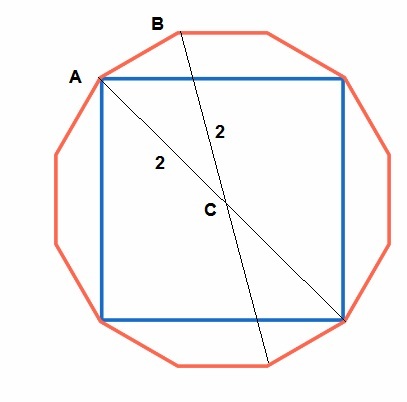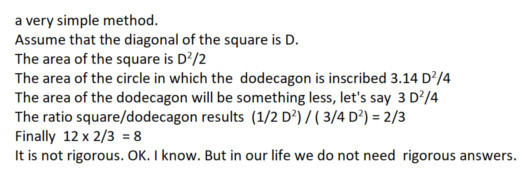A Square In A Dodecagon
A square is inscribed in a regular dodecagon--a regular polygon with 12 sides--so that they share 4 vertices, as shown.
If the area of the dodecagon is 1 2 , what is the area of the square?
The answer is 8.
This section requires Javascript.
You are seeing this because something didn't load right. We suggest you, (a) try
refreshing the page, (b) enabling javascript if it is disabled on your browser and,
finally, (c)
loading the
non-javascript version of this page
. We're sorry about the hassle.
4 solutions
Is there a figurative way to see that the area is 2 : 3 ?
Log in to reply
I edited my solution to include one way, although it is not intuitive. By the way, I came across this ratio after noticing that the square and the dodecagon are the only regular polygons with central angles whose sines have no radicals (sin 90 and sin 30).
NOTE: In case, you are not aware of the formula 2 n R 2 sin ( n 3 6 0 ∘ ) , then the method below will help you.
Let the side of the polygon = a units
Let the apothem of the polygon = b units
We observe that the side of a square = 2 a cos 3 0 o + a = ( 3 + 1 ) a ... (i)
Since the polygon is regular, we can find the angles subtended at various positions as shown. Use the n ( n − 2 ) 1 8 0 o formula to find the internal angles subtended by the sides, where n is the number of sides of the regular polygon. To find the angle at the centre made by the triangle, simply divide n 3 6 0 . The regularity allows for the angles to be bisected. The values thus obtained are in the figure above.
Area of any polygon = 2 1 x apothem x perimeter = 2 1 x b x 1 2 a = 6 a b
⟹ 1 2 = 6 a b
⟹ a b = 2 ... (ii)
Now to find b , we make the triangle as shown in the figure.
b = 2 a x tan 7 5 o = 2 ( 3 − 1 ) a ( 3 + 1 ) ... (iii)
Putting (iii) in (ii);
2 ( 3 − 1 ) a 2 ( 3 + 1 ) = 2
⟹ a 2 = 3 + 1 4 ( 3 − 1 ) ... (iv)
Area of Square from (i) = a 2 ( 3 + 1 ) 2
Using (iv):
Area of Square = 3 + 1 4 ( 3 − 1 ) x ( 3 + 1 ) 2 = 4 ( 3 − 1 ) = 8 square units
 Total area = 12 = 12 x Area of
△
A
B
C
⟹
Area of
△
A
B
C
=
1
Total area = 12 = 12 x Area of
△
A
B
C
⟹
Area of
△
A
B
C
=
1
Area of △ A B C = 2 A C × B C sin 3 0 = 1 ⟹ A C = B C = 2
The diagonal of the given square = 4 and the Square area = 8;
Nice, simple solution! I think some of your sides are mixed up, though (AB x BC sin 30 should be AC x BC sin 30 and AB = AC = 2 should be BC = AC = 2)

The area of a regular polygon with n sides inscribed in a circle of radius R is A = 2 n R 2 sin ( n 3 6 0 ) , which means the area of a regular dodecagon (when n = 1 2 ) is A = 3 R 2 and the area of a square (when n = 4 ) inscribed in the same circle is A = 2 R 2 . The ratio between the area of a square and the area of a dodecagon inscribed in the same circle is therefore 3 2 , so the area of the above square can be found by solving the proportion 1 2 x = 3 2 , which is 8 .
The picture below shows that the ratio between the area of the square inscribed in a regular dodecagon in this way is 3 2 the area of the regular dodecagon:
where each smaller triangle or quadrilateral of the same color are congruent, and can be rearranged to form the following large triangle found in the square,
and rearranged again to form the following large triangle found in the regular dodecagon:
at the following side ratios and angles: